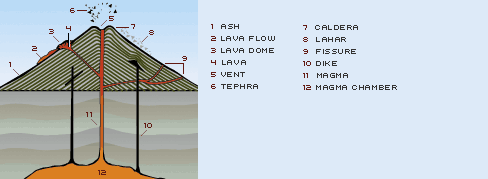

|

|
Introduction
There are many different kinds of volcanoes, ranging from the
Hawaiian type, which produces gentle, effusive eruptions that
tourists can observe from mere steps away, to the andesitic variety,
which can produce violent, life-threatening Plinian eruptions with
little or no warning. Though volcanologists study all types of
volcanoes, the latter kind is of greatest concern since it is
capable of killing thousands of people, destroying entire cities and
forests, and severely disrupting local economies.
The volcanoes featured in the NOVA program "Volcano's Deadly
Warning"—Galeras, Nevado del Ruiz, Popocatepetl, and Mt.
Redoubt—as well as many other famous volcanoes, including Mt.
St. Helens and Mt. Vesuvius, are all andesitic volcanoes. Here, get
to know the major features and products of an andesitic volcano,
which forms when two tectonic plates rub against each other and
generate enough friction and heat to create magma from melted rock.
This magma surges through the surface of the earth, then solidifies,
resulting over time in a classic volcano cone. —Lexi Krock
Note: Some of the text in this feature is adapted from materials
produced by the U.S. Geological Survey. An extensive volcano
glossary can be found at
volcanoes.usgs.gov.
Above left: Mt. St. Helens, a grande dame among andesitic
volcanoes, erupts on July 22, 1980.
|



